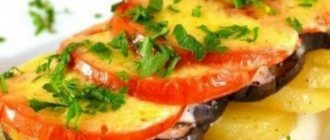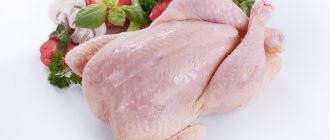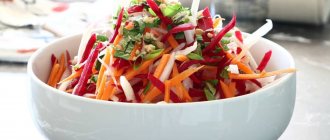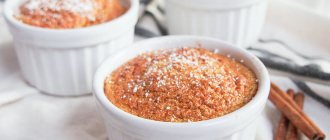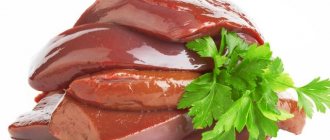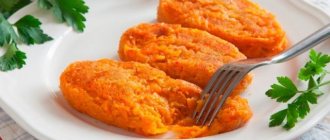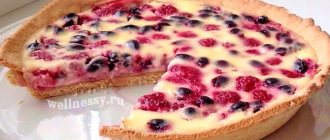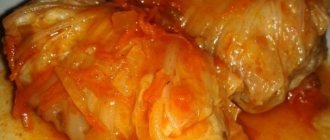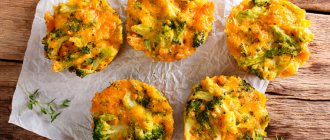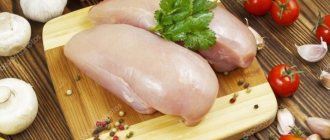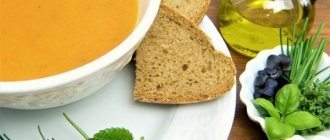8
Prepared by: Julia Vetrina
03/14/2016 Cooking time: 1 hour 30 minutes
| Save | I cooked) | Estimate |
Everyone is slowly starting to prepare for the beach season. And more and more dietary dishes are appearing in the diet. Well, I decided not to lag behind, I will also share one recipe.
How to eat to lose weight
To easily lose weight without harm to your health, it is important to adhere to the basic principles of proper nutrition. Eat small meals - often, but little by little. Avoid starchy, sweet and fatty foods. Replace difficult-to-digest and high-calorie pork with chicken fillet, turkey and rabbit.
Try to cook without oil or fat; in extreme cases, use healthy olive oil. Eat foods low in carbohydrates and fat. As a side dish, eat any vegetables except potatoes. Try to drink more water.
One of the suitable recipes for a diet, especially for a protein diet, is diet lazy cabbage rolls in the oven. They are prepared from lean meat with the addition of vegetables and seasonings. This dish is perfectly filling, healthy and low-calorie, it contains practically no carbohydrates.
Recipe for lazy dietary cabbage rolls. Calorie, chemical composition and nutritional value.
Nutritional value and chemical composition of “dietary lazy cabbage rolls”.
The table shows the nutritional content (calories, proteins, fats, carbohydrates, vitamins and minerals) per 100 grams of edible portion.
| Nutrient | Quantity | Norm** | % of the norm in 100 g | % of the norm in 100 kcal | 100% normal |
| Calorie content | 121.2 kcal | 1684 kcal | 7.2% | 5.9% | 1389 g |
| Squirrels | 13 g | 76 g | 17.1% | 14.1% | 585 g |
| Fats | 2 g | 56 g | 3.6% | 3% | 2800 g |
| Carbohydrates | 12.6 g | 219 g | 5.8% | 4.8% | 1738 g |
| Organic acids | 0.1 g | ~ | |||
| Alimentary fiber | 1.5 g | 20 g | 7.5% | 6.2% | 1333 g |
| Water | 75.8 g | 2273 g | 3.3% | 2.7% | 2999 g |
| Ash | 1.214 g | ~ | |||
| Vitamins | |||||
| Vitamin A, RE | 53.5 mcg | 900 mcg | 5.9% | 4.9% | 1682 g |
| Retinol | 0.021 mg | ~ | |||
| beta carotene | 0.031 mg | 5 mg | 0.6% | 0.5% | 16129 g |
| beta Cryptoxanthin | 0.103 mcg | ~ | |||
| Lycopene | 0.013 mcg | ~ | |||
| Lutein + Zeaxanthin | 0.438 mcg | ~ | |||
| Vitamin B1, thiamine | 0.059 mg | 1.5 mg | 3.9% | 3.2% | 2542 g |
| Vitamin B2, riboflavin | 0.103 mg | 1.8 mg | 5.7% | 4.7% | 1748 g |
| Vitamin B4, choline | 37.16 mg | 500 mg | 7.4% | 6.1% | 1346 g |
| Vitamin B5, pantothenic | 0.175 mg | 5 mg | 3.5% | 2.9% | 2857 g |
| Vitamin B6, pyridoxine | 0.092 mg | 2 mg | 4.6% | 3.8% | 2174 g |
| Vitamin B9, folates | 13.369 mcg | 400 mcg | 3.3% | 2.7% | 2992 g |
| Vitamin B12, cobalamin | 0.044 mcg | 3 mcg | 1.5% | 1.2% | 6818 g |
| Vitamin C, ascorbic acid | 18.71 mg | 90 mg | 20.8% | 17.2% | 481 g |
| Vitamin D, calciferol | 0.188 mcg | 10 mcg | 1.9% | 1.6% | 5319 g |
| Vitamin E, alpha tocopherol, TE | 0.167 mg | 15 mg | 1.1% | 0.9% | 8982 g |
| gamma tocopherol | 0.01 mg | ~ | |||
| Vitamin H, biotin | 2.289 mcg | 50 mcg | 4.6% | 3.8% | 2184 g |
| Vitamin K, phylloquinone | 32.9 mcg | 120 mcg | 27.4% | 22.6% | 365 g |
| Vitamin RR, NE | 5.7822 mg | 20 mg | 28.9% | 23.8% | 346 g |
| Niacin | 5.166 mg | ~ | |||
| Betaine | 0.019 mg | ~ | |||
| Macronutrients | |||||
| Potassium, K | 290.53 mg | 2500 mg | 11.6% | 9.6% | 860 g |
| Calcium, Ca | 32.82 mg | 1000 mg | 3.3% | 2.7% | 3047 g |
| Silicon, Si | 14.245 mg | 30 mg | 47.5% | 39.2% | 211 g |
| Magnesium, Mg | 51.13 mg | 400 mg | 12.8% | 10.6% | 782 g |
| Sodium, Na | 126.49 mg | 1300 mg | 9.7% | 8% | 1028 g |
| Sera, S | 42.42 mg | 1000 mg | 4.2% | 3.5% | 2357 g |
| Phosphorus, P | 123.2 mg | 800 mg | 15.4% | 12.7% | 649 g |
| Chlorine, Cl | 162.03 mg | 2300 mg | 7% | 5.8% | 1419 g |
| Microelements | |||||
| Aluminium, Al | 272.1 mcg | ~ | |||
| Bor, B | 116.8 mcg | ~ | |||
| Iron, Fe | 1.327 mg | 18 mg | 7.4% | 6.1% | 1356 g |
| Yod, I | 3.4 mcg | 150 mcg | 2.3% | 1.9% | 4412 g |
| Cobalt, Co | 6.514 mcg | 10 mcg | 65.1% | 53.7% | 154 g |
| Manganese, Mn | 0.2907 mg | 2 mg | 14.5% | 12% | 688 g |
| Copper, Cu | 120.48 mcg | 1000 mcg | 12% | 9.9% | 830 g |
| Molybdenum, Mo | 10.207 mcg | 70 mcg | 14.6% | 12% | 686 g |
| Nickel, Ni | 7.009 mcg | ~ | |||
| Rubidium, Rb | 33.9 mcg | ~ | |||
| Selenium, Se | 4.995 mcg | 55 mcg | 9.1% | 7.5% | 1101 g |
| Fluorine, F | 18.38 mcg | 4000 mcg | 0.5% | 0.4% | 21763 g |
| Chromium, Cr | 13.55 mcg | 50 mcg | 27.1% | 22.4% | 369 g |
| Zinc, Zn | 1.0885 mg | 12 mg | 9.1% | 7.5% | 1102 g |
| Digestible carbohydrates | |||||
| Starch and dextrins | 9.708 g | ~ | |||
| Mono- and disaccharides (sugars) | 2.7 g | max 100 g | |||
| Glucose (dextrose) | 1.217 g | ~ | |||
| Maltose | 0.024 g | ~ | |||
| Sucrose | 0.689 g | ~ | |||
| Fructose | 0.779 g | ~ | |||
| Essential amino acids | 0.177 g | ~ | |||
| Arginine* | 0.966 g | ~ | |||
| Valin | 0.708 g | ~ | |||
| Histidine* | 0.63 g | ~ | |||
| Isoleucine | 0.605 g | ~ | |||
| Leucine | 1.058 g | ~ | |||
| Lysine | 1.273 g | ~ | |||
| Methionine | 0.261 g | ~ | |||
| Methionine + Cysteine | 0.495 g | ~ | |||
| Threonine | 0.583 g | ~ | |||
| Tryptophan | 0.199 g | ~ | |||
| Phenylalanine | 0.588 g | ~ | |||
| Phenylalanine+Tyrosine | 1.08 g | ~ | |||
| Nonessential amino acids | 0.417 g | ~ | |||
| Alanin | 0.706 g | ~ | |||
| Aspartic acid | 1.09 g | ~ | |||
| Hydroxyproline | 0.09 g | ~ | |||
| Glycine | 0.498 g | ~ | |||
| Glutamic acid | 1.665 g | ~ | |||
| Proline | 0.54 g | ~ | |||
| Serin | 0.585 g | ~ | |||
| Tyrosine | 0.49 g | ~ | |||
| Cysteine | 0.238 g | ~ | |||
| Sterols (sterols) | |||||
| Cholesterol | 52.99 mg | max 300 mg | |||
| Phytosterols | 0.197 mg | ~ | |||
| beta sitosterol | 3.704 mg | ~ | |||
| Saturated fatty acids | |||||
| Saturated fatty acids | 0.5 g | max 18.7 g | |||
| 14:0 Miristinovaya | 0.009 g | ~ | |||
| 15:0 Pentadecane | 0.001 g | ~ | |||
| 16:0 Palmitinaya | 0.374 g | ~ | |||
| 17:0 Margarine | 0.003 g | ~ | |||
| 18:0 Stearic | 0.119 g | ~ | |||
| 20:0 Arakhinovaya | 0.007 g | ~ | |||
| Monounsaturated fatty acids | 0.776 g | min 16.8 g | 4.6% | 3.8% | |
| 16:1 Palmitoleic | 0.085 g | ~ | |||
| 17:1 Heptadecene | 0.005 g | ~ | |||
| 18:1 Oleic (omega-9) | 0.645 g | ~ | |||
| 20:1 Gadoleic (omega-9) | 0.003 g | ~ | |||
| Polyunsaturated fatty acids | 0.231 g | from 11.2 to 20.6 g | 2.1% | 1.7% | |
| 18:2 Linolevaya | 0.204 g | ~ | |||
| 18:3 Linolenic | 0.01 g | ~ | |||
| 20:4 Arachidonic | 0.017 g | ~ | |||
| Omega-6 fatty acids | 0.2 g | from 4.7 to 16.8 g | 4.3% | 3.5% |
The energy value of dietary lazy cabbage rolls is 121.2 kcal.
Primary Source: Created in the application by the user. Read more.
** This table shows the average levels of vitamins and minerals for an adult. If you want to know the norms taking into account your gender, age and other factors, then use the “My Healthy Diet” application.
Oven cooking options
Stuffed cabbage rolls made from lean meat, as in the photo above, are in no way inferior in taste to regular ones, but they are much healthier, easier to digest and easier to prepare. Recipes for dietary lazy cabbage rolls require minimal labor compared to regular ones, hence the name.
Advice! Using a non-stick mat will help you avoid adding oil altogether.
Classic dish
Ingredients:
- chicken fillet – 300 g;
- white cabbage – 300g;
- 1 chicken egg;
- 1 onion;
- 1 carrot;
- a bunch of fresh herbs, preferably parsley;
- brown rice – 50 g;
- natural tomato paste – 2 tbsp;
- salt and spices;
- olive oil.
Step 1. Wash the fillet and dry with paper towels. Pass it through a meat grinder along with onions, cabbage and carrots. You can use a blender.
Step 2 . Mix the ingredients, add tomato paste, cooked rice, salt, spices, chopped parsley to the minced meat. Separate the white from the yolk, beat the white a little in a separate glass and pour into the mixture. Mix everything with your hands.
Step 3. Grease a baking sheet with olive oil, form small balls of minced meat, place them on it at a distance of about a couple of centimeters from each other. Place the baking sheet with diet cabbage rolls in the oven, preheated to 200 degrees, and wait 50 minutes.
Interesting! The laziest housewives know how to prepare diet cabbage rolls using the simplest, easiest method. You don’t need to form the minced meat into balls, but simply simmer the mass in a deep frying pan with water. In this case, you will get a meat sauce that tastes like cabbage rolls. You can put it separately on vegetables and eat it with pleasure.
From Chinese cabbage
Very airy and light dietary cabbage rolls made from Chinese cabbage are perfect for a low-calorie diet. This type of cabbage is easier to roll, cooks faster and has an interesting taste.
Ingredients:
- a head of Chinese cabbage;
- minced chicken breast – 0.5 kg;
- 70 g brown rice;
- 2 onions;
- 1 medium carrot;
- natural tomato paste – 30 g;
- olive oil – 60 g;
- salt;
- peppercorns and ground;
- 4 bay leaves;
- water.
Step 1. First, wash the rice and boil it until half cooked in salted water.
Step 2. Peel the cabbage from the top leaves, cut at a distance of about 5 cm from the base. Take it apart into sheets and wet each of them separately with water.
Step 3. Place a pot of boiling water and a bowl of very cold water next to it. Place the leaves in boiling water for 3 minutes and then transfer them to a second bowl. This way you will ensure that the leaves are not tough, and it will be easier to wrap the minced meat in them.
Step 4. Peel all the vegetables, cut or chop them, fry them in olive oil or without oil in a non-stick frying pan.
Step 5. Divide the resulting mass of fried vegetables into two parts, one will go into the filling, and the other will go into the gravy. Combine the first part with minced chicken and rice, mix everything, add salt and ground pepper.
Step 5. Take a board, lay out a cabbage leaf on it, and spoon the resulting filling mixture onto it. Fold the sheet and place it seam side down.
Advice! You can tie the cabbage roll with a sprig of parsley or regular thread, which after cooking can be cut and thrown away.
Step 6. Add a little olive oil to the pan, heat it and fry the cabbage rolls on both sides until golden brown.
Step 7. Place the second part of the fried vegetables in a deep frying pan, add tomato paste, salt and pepper, stir everything, distribute the cabbage rolls on top and pour in water so that its level slightly covers the products. Place the pan in the oven for half an hour - you will get amazingly tasty low-calorie cabbage rolls.
Without meat
The recipe for diet cabbage rolls without meat is suitable for those who want to lose weight quickly, as well as vegetarians. It can be consumed during fasting.
Ingredients:
- 400 g carrots;
- 400 g rice;
- 80 g olive oil;
- 0.5 kg head of cabbage;
- 1 large onion;
- 0.5 tsp each ground red and black pepper;
- fresh greens.
Step 1. Take a pan, pour olive oil into it, place the onion cut into half rings, and start frying it. After a few minutes, add finely shredded cabbage, and a little later, grated carrots. Add seasonings to your vegetables that you like.
Step 2. Add vegetable broth or purified water to the pan until it covers the vegetables halfway. Simmer them for about 8 minutes.
Step 3: Rinse the rice without stopping until the water runs clear. Place it on top of the vegetables, fill everything again with broth or water so that it is about 2 cm above the rice.
Step 6. Place the saucepan in the oven, without closing the lid, keep it there until the water evaporates. You can use a double boiler.
Step 8. Take out the dish and leave it covered for about 15-20 minutes. After that, sprinkle it with herbs and serve.
Interesting!
Ingredients:
- 600-700 g of meat (I have chicken fillet + veal)
- 600 g cabbage (medium head)
- 120 g rice
- 200 g carrots
- 1 large onion
- 1 tomato
- Fresh herbs - dill, parsley
- Salt and pepper to taste.
For the gravy:
- 500 g of tomato juice (you can take 200 g natural ketchup, then increase the amount of water)
- 200 g Sour cream;
- 200 g water;
- 1 teaspoon sugar;
- Salt and pepper to taste.
Tips and tricks
In order to get tasty and healthy dietary cabbage rolls, use the following recommendations:
- Try placing the cabbage on the bottom of a baking sheet and placing small balls of minced meat on top. Place everything in the oven and bake; halfway through the process, use a wooden spatula to wrap the minced meat in leaves and place cut side down. This way you will get delicious lazy cabbage rolls.
- Serve diet cabbage rolls with a vegetable salad of tomatoes and cucumbers or fresh cabbage - this will make the dish even healthier and tastier.
- You can also cook cabbage rolls in a double boiler; in this case, you need to place them in a bowl or on a wire rack for about 30 minutes, and after cooking, pour over a sauce made from natural yogurt, salt, spices and lemon juice.
- To get dietary lazy cabbage rolls, use chicken breast, turkey fillet, lean beef or rabbit. The meat can be minced in a meat grinder or chopped very finely.
- If you don't have tomato paste, you can use regular tomatoes. Cut off the top, scald with boiling water and remove the skin, grind the pulp using a blender, add a little lemon juice, salt and ground black pepper.
Recommended and prohibited foods for diet 5
When you hear the expression “5 dietary products for the table,” you imagine a rather limited list, but this is not at all the case. Based on permitted products, you can prepare a huge number of original dishes; monotony, blandness of the menu, and hunger are excluded. Boiling, steaming, stewing are the main heat treatment technologies; frying can be left as a last resort or eliminated altogether.
A very important point is split meals; on diet 5 you should organize 5-6 meals (it’s better to eat more often, but in small portions). This approach is optimal: it speeds up metabolism and does not allow the body to starve.
Nutritionists consider the optimal daily intake to be 1200-1600 kcal. (for women and men, respectively, and also taking into account age, body condition, individual characteristics). This range is quite acceptable so that diet table 5 can be used without time restrictions.
It often happens that we use therapeutic diets after any disease has already made itself felt. Try to use table 5 right now, this will keep the liver and gastrointestinal tract healthy, and excess weight will no longer be a problem - the weight loss process will begin literally immediately, the first result will be clearly noticeable from the outside within two to three weeks, and after a few months the scales will stop, fixing the most physiological weight for you.
What you can eat, what foods are suitable for the table 5:
- Bread and flour products: allowed: wheat flour grades 1 and 2, peeled rye, yesterday's bread made from it. A simple pastry filled with cottage cheese, apples, fish and meat.
- Exclude: fresh bread, fried pies, puff pastry and butter.
- Meat products and fish with low fat content: allowed: lean pork, beef, poultry without skin and tendons (best boiled and then baked), boiled sausage and frankfurters. Any pickling, smoking or preservation are excluded.
- Eggs: 1 yolk for cooking, steamed egg white omelette. Avoid fried and boiled ones.
- Dairy products: up to 9% fat, cheese – up to 17% fat (unsalted);
- Cereals: all without exception, but reduce the consumption of millet, corn grits and barley;
- vegetables: all (except pickled), but reduce cabbage consumption;
- soups: vegetable broth, strong meat broths are not allowed, on table 5 for soup you need to boil the meat separately, drain the water and add the finished meat to the plate or at the very end of cooking
- fats: vegetable oils up to 15 g, butter 30 g
- sweets: jelly, jelly, mousses, puddings, curd desserts, fruits (except sour);
- Drinks: herbal teas, coffee perhaps, but with milk or a coffee substitute (chicory, for example), non-sour vegetable and fruit juices.
What should not be on the table during diet 5:
- fat and lard (pork, lamb, etc.)
- chocolate and cocoa, ice cream;
- fresh bread, rich fresh pastries, cakes
- meat: fatty types (goose, lamb, duck)
- smoked and canned meat, sausages
- fish: fatty species and caviar
- soups: meat, fish, cold, raw vegetables, mushrooms;
- dairy products: acids (more than 9%) and salts;
- sauces and spices: horseradish, mustard, reduce salt intake (10 g) and pepper;
- beans, spinach, sorrel, onions (raw and green - arrows-feathers), garlic
- Drinks: alcohol, black coffee, cocoa, any cold drinks.
It’s easy to follow all the recommendations; you can easily create a balanced menu based on them. The total calorie content is about 1600 Kcal, the required amount of protein is at least 80 g - an ideal and tasty menu for every day. Examples of recipes for the table 5 will help you understand the principle of the diet and, perhaps, inspire you to create new culinary variations.
